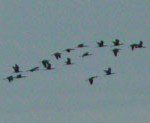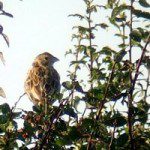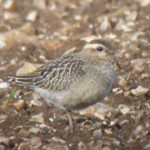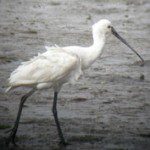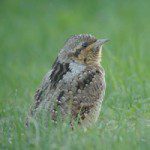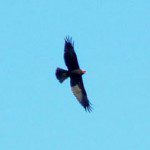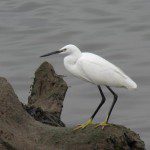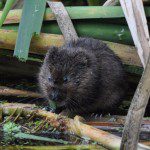NB: The following is reproduced by kind permission of Axe Estuary Birds. Full credit goes to the team that produces the newsletter (see the bottom of the post for specific details). Photographs are credited throughout the text although we are working to preserve the original layout wherever possible in the future.
Axe Estuary Birds No 140 15th September 2010
Photos: Glossy Ibis – Gavin Haig; Dotterel – Steve Waite; Corn Bunting – Gavin Haig; Spoonbill – Steve Waite; Wryneck – Karen Woolley; Marsh Harrier – Gavin Haig; Little Egret at Black Hole Marsh and Water Vole at The Borrow Pit – Sue Smith
The Birds
Well the summer has certainly passed us, anyone else notice it? I didn’t!!! September is probably the best month of the year for migration and passage – and this year did not disappoint. We’ve had some nice rares too..
The River Otter was graced by a stunning flock of 20 Glossy Ibis for about a week from 6th. But at 07:22 on 13th, 18 of them flew east over Beer Head and up the river valley. Unfortunately they didn’t stop – and incredibly by 3.00 pm the same day, they were seen at Dungeness in Kent! Quite why two have decided to stay on the Otter I don’t know, you would assume the flock would have stuck together. There was an earlier report of a Glossy Ibis too for the patch, with one noted in the log book at Seaton Marshes on the same day the twenty appeared on the Otter.
Next best bird goes to an approachable Dotterel that was discovered at Axe Cliff on 5th, and remained ’til 7th at least. It spent its time in the first field east of the golf course, one field in from the cliff-edge. This is the third record for the patch of this northern breeder.
Yet another rare bird, on a County scale anyhow, was a Corn Bunting on Beer Head. It was first seen on the evening of 12th, and was showing again on 15th with a small flock of Yellowhammers. This species used to be common in the southwest, but is now extinct from Devon and Somerset, with only a few left in Cornwall and Dorset. Quite why they are faring so poorly is unknown – must be mostly down to the change in farming practices.
On 7th a Spoonbill was a rather brief visitor to the Estuary. It spent its time here feeding at the mouth of the channel of water that runs out from Seaton Marshes Hide.
Last of the ‘goodies’, and this one slightly north of the usual area covered by this newsletter, was a Wryneck at Waggs Plot (just north of Axminster). It was first found on 12th and present until the 14th at least. There have been good numbers of Wrynecks about this autumn, and they are a bird that could turn up on any lawn in any garden, so please keep your eyes peeled for one!
So that’s the ‘rares’ dealt with, time to get in with the more usual bits and bobs….
As it is getting to the winter, I shall mention the wildfowl. Numbers of Teal have been good, with 132 counted on 10th, along with nine Wigeon. Unusual wildfowl have included three Pintail on 31st Aug, and a female Goosander on the Estuary on 2nd.
Wading bird numbers have been varied on the Estuary and Black Hole Marsh. Little Stints peaked at seven on 7th (a very good count!), Curlew Sandpipers peaked at three on 2nd, and other interesting bits and bobs included a Knot from 7th – which increased to two on 11th, and a Bar-tailed Godwit on 2nd which increased to a notable six by the 14th. A Ruff was seen at Colyford Marsh on 8th and 10th.
Notable raptors have included the now expected Osprey, on 11th, although it didn’t stay long at all and soon headed south out to sea. Less expected were two Marsh Harriers. Single ‘cream-crowned’ birds were over Colyford Marsh on 30th August and 13th.
Barn Owls have been pleasingly regular over the last few weeks, with Black Hole and Seaton Marshes both proving good sites. As expected with this species, dusk is best, but one has been seen hunting over Black Hole Marshes mid morning on a couple of occasions!
The Trivia
According to the RSPB, in 2010 the Bittern enjoyed its most successful breeding season ever, since its recolonisation of the UK in 1911. This success is even more remarkable considering the long spell of cold weather earlier in the year, which was known to have adversely affected Bitterns at many sites.
The UK monitoring programme for Bitterns revealed the presence of 87 males, delighting those who have worked so hard to prevent this bird from becoming extinct in Britain for a second time. The programme recorded 82 males last year, the previous record year.
Black Hole Marsh hide is progressing well, and may be open by the end of the month. The birds do not seem fazed by all the activity, and on the 14th we saw Green Sandpiper, Curlew Sandpiper, Wood Sandpiper, Common Sandpiper, Dunlin, Swan, Mallard, Shelduck, Shoveler and Little Egret.
The British Ornithologists’ Union Records Committee (BOURC) has accepted the following to Category A of the British List:- Amur Falcon, Tufted Puffin, Eastern Crowned Warbler, ‘Siberian’ Pied Flycatcher, and Citril Finch. This brings the total on the British List to 592 species – a bit more than most of our Lifetime Lists. Ah well, let’s just enjoy all those we do see!
The first Meet the Birds session of the season was in wonderful weather, and we were entertained by a very active Kingfisher, many Canada Geese and Curlews, one solitary Wigeon, half a dozen Grey Herons, four Little Egrets, Mallards, Swans, Crows, Green Sandpiper, Shelduck, Cormorants, Greenfinch – and probably others which I have forgotten. Bodes well for the autumn and winter.
Maggie & Ray Dilley write “Still enjoying the newsletter, thanks to all involved. Can anyone give us some advice please……………..
Every year we have slow worms in our compost bins. A couple of months ago we had a medium size grass snake curled up under the carpet in one bin. Then yesterday we had a young grass snake with the slow worms. Question is……….. will they all want to hibernate in the compost? So when can we safely move it onto our veg plot?”
Any ideas, anyone? Please let me know at davidwalters@eclipse.co.uk
Diary Dates
Saturday 18th September 8am – Noon Ringing Breakfast at Colyford Common.
Approx (If weather is very wet, this will be cancelled)
Saturday 18th September 5pm-7pm Birds from the Tram, with Ian Waite.
Sunday 19th September 10am – Noon Seaton Beach clean. Meet Fisherman’s Gap. Wear gloves
and bring a pencil.
Thursday 23rd September 10am – Noon Meet the Birds, Seaton Marshes Hide. Everyone welcome.
Saturday 25th September 9am to 1pm Bird Watch at Dawlish Warren with Ian Waite. Meet at
Dawlish Warren Car Park.
Saturday 25th September 2.30pm onwards Goose Fair, Colyford.
Thursday 28th October 7.30 pm Illustrated talk “The Birds of Devon” by Mike Tyler, Chairman of
DBWPS. At All Saints Church, Sidmouth.
Every Tuesday, Thursday and Saturday from 10.00 a.m. to 4.00 p.m. Biodiversity Exhibition at the old TIC in Seaton’s Underfleet Carpark, with various informal walks and talks – more details at the Exhibition or phone 01395 517557.
This twice-monthly email newsletter is freely available to anyone who would like it, as is a periodic one about the activities of the East Devon Local Group of the Devon Wildlife Trust. Just send me an email with Axe Estuary Birds and/or East Devon DWT in the subject line. Also, for those without a computer, I will send a copy by post if you would like to send me some stamps.
Thanks to those who keep me informed – please continue to tell us of any unusual, interesting or amusing sightings, and what is about locally, and send any photos you would like to share.
Steve, and David. davidwalters@eclipse.co.uk. tel. 01297 552616 Mobile 0779 1541 744.

